The most desperate landing in history
 Bashny.Net
Bashny.Net
Soft touch and cheerful clatter of wheels on the tarmac - not a reason for applause. Ironically, the most powerful in the history of the collapse of civil aviation did not occur in the air and on the ground.
In 1977, the Canary La Palma Airport rattled explosion - Bomb terrorist without harming anyone, but it was the first act in chrede horrific events of that day. All inbound planes were redirected to the small airport of Los Rodeos on the island. Tenerife, where fog, inexperienced manager and a crowded tarmac completed the begun. On the runway collision between two "747" filled with "the eyeballs" of fuel and passengers. 583 people have ascended to heaven without the help of aircraft.
Continued under the cut ...

Similarly ended landing at Irkutsk airport (2006). Already landing Airbus A-310 was deployed and cleared the runway left engine, which, as a result of erroneous actions of the crew accidentally moved during takeoff. The aircraft was destroyed and burned from aboard more than two hundred people were able to save only 78.
And yet, despite all the prejudices, aviation remains one of the safest modes of transport. Air crashes happen far less frequently than road accidents or fatal lightning strikes. Even when the engine is switched off, the failure of the control system and the landing gear stuck - on board the passengers have a good chance to return safely to the ground. Instead of hovering faulty computers and mechanization raises the human mind and inexhaustible will to win.
In the world every day is made of 50 thousand commercial flights.
1.11.2011 When approaching the Polish airport the aircraft, which fly New York - Warsaw, there were problems with the chassis. Boeing made several circles over the airport, after which the crew decided to land, according to RIA "Novosti". The aircraft made a hard landing successfully.
On board were 230 people. People brought out through the "sleeve».
On the platform they say - it is the city of Leningrad (1963)
The story of the miraculous rescue of the aircraft, which, in an attempt to prevent the fall in the middle of the northern capital, managed to splash down on the Neva.
The background is as follows: passenger airliner Tu-124 en route flight Tallinn - Moscow reported about the problems encountered on board. Immediately after takeoff, the nose landing gear jammed in poluubrannom position. The nearest airport, where it was possible to land the plane crash "in the belly" was the Leningrad airport "Pulkovo" (in those days - "highway"). There it was decided to send a "carcass».
Upon arrival, the ship began to "cut circles" over Leningrad. For the early generation of fuel he circled at an altitude of less than 500 meters, at which time the crew is actively trying to unlock the mechanism of the chassis with a metal pole. During this exciting experience and they found the news to stop the left engine due to lack of fuel. The commander and co-pilot ran to the wheel and received permission to fly over the city through urgently taken "carcass" in the direction "Pulkovo". At this time, it stops the second motor. Clearance is not enough, even on the withdrawal of the aircraft outside the Old town, this time the aircraft commander Victor Y. Mostovoy took the only right decision - to try to land the plane in the clamped in granite coast Neva. Airliner passed at a height of 90 m Foundry Bridge, ran 30 meters above Bolsheokhtinsky bridge, jumped at a height of several meters under construction bridge of Alexander Nevsky and fell into the water, almost catching wing steam tug.
Planting has turned out to be surprisingly soft: all the 45 passengers and seven crew members survived. The pilots, according to tradition, immediately took his hands KGB, however, soon had to let go of all due to the interest of the international media to this incredible landing and heroes whose actions saved five dozen people from seemingly completely hopeless situation.

The race to the death
December 31, 1988 the crew of the Tu-134 in such a hurry for the holiday table, I chose the steepest decline trajectory, ignoring the heart-rending cries of alarm too fast and rapidly approaching the earth. At speed of 460 km / h in violation of all rules and regulations were issued by the chassis. Flaps it was too late - at this speed the air flow just tore them "meat».
The speed at the moment of contact was 415 km / h (the maximum permissible value under the terms of the strength of the chassis 330 km / h). Thus, the crew of the Soviet ship found so far no one unbroken record of landing speed in civil aviation. When the 6 seconds, the speed was reduced to 380 km / h, drivers, pilots for the first time the whole flight thinking about how they would slow down. Despite all the measures taken by them (reverse engines, flaps and spoilers, deceleration) plane still skidded off the runway and stopped on the runway safety, 1, 5 meters from the descent to the ground. Fortunately, the incident affected only the head of careless drivers.

Fly gigs Aloha Airlines!
In the same 1988 there was another amazing event.
In an old "Boeing", carrying out flight from Hilo - Honolulu (Hawaiian Islands) due to explosive decompression blew off 35 square meters. meter fuselage skin. The incident occurred at an altitude of 7300 meters at a flight speed of 500 km / h. 90 passengers in an instant turned into a roaring stream of air, the speed of which is 3 times the speed of the hurricane; when the air temperature behind -45 ° S.Piloty urgently declined and dropped the speed to 380 km / h, however, 65 people had to pour injuries and frostbite of varying severity. After 12 minutes the plane with a minute deviation from landing at the airport of Honolulu.
The only victim of the accident was unusual stewardess - unhappy thrown overboard at the time of the destruction of the fuselage.
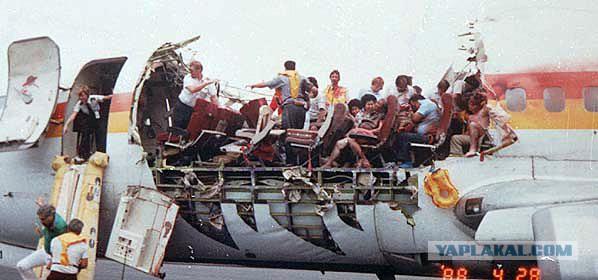
"Gimli Glider" (1983) and "The pilots of the Century" (2001)
"Gimli Glider" - a name wore Boeing 767-233 (w / C-GAUN 22520/47) airlines Air Canada, has made an amazing feat. 132-ton airplane to stop the engine carefully planned with a height of 12 000 meters and landed safely at an abandoned airbase Gimli (where at the moment carried out racing). The situation is complicated power shortages, resulting in disconnected many flight instruments. A hydraulic pressure was so low that the pilots could barely move with the ailerons and rulyami.Prichina incident - error airport ground services in Ottawa, muddle kilograms and pounds. As a result, the tanks of the aircraft instead of the required 20 tonnes received less than 5 tons of kerosene. The situation was saved only presence in the cockpit of an experienced CF Robert Pearson (at leisure - glider amateur) and co-pilot, a former military pilot M.Kvintala who knew of the existence of an abandoned runway Gimli.
Interestingly, a similar incident occurred in 2001 when the Atlantic Ocean stalled engines of the French "Airbus" flying from Toronto Lisbon. KBC Robert Piché
and co-pilot Dirk de Jager able to fly on the "glider" and another 120 km to make a soft landing at Lajes Air Base in the Azores.

Flying over the crater of the volcano (1982)
... The flight attendant handed a cup of coffee and, as if by chance, looked out the window. Seen behind left no doubt: fear of the pilots were not in vain. From both engines came strange glow, like a flash strobes. Soon, the cabin appeared suffocating smell of sulfur and smoke. Commander Eric Moody was forced to make one of the most naive statements in the history of civil aviation:
"Ladies and gentlemen, said the commander of the aircraft. We have a small problem, all four engines stopped. We do our best to start them. I hope this does not cause you too much trouble »
No one at that time was on board 248 passengers and 15 crew members had no idea that "747" flew through the cloud of volcanic ash ejected suddenly awakened volcano galunggung (Indonesia). The smallest abrasive particles scored engines and fuselage skin damaged by putting flight №9 (London-Oakland) to the brink of disaster.
The huge ship was planning a night on the ocean. Straight ahead I grew ridge on the south coast of. Java. The crew had to decide - whether they have enough height to fly over the barrier and make an emergency at the airport in Jakarta, and is immediately put into the water jet. While KBC together with the Indonesian controller calculated the remaining distance and aerodynamic quality of the aircraft, the co-pilot and flight engineer did not stop efforts to restart the engines. And, lo and behold! Fourth motor sneezing, spitting out volcanic pumice ourselves, and rhythmically jerk whistle. Gradually I managed to put into operation two of the engine - thrust was enough to make it to the airport, but on the landing glidepath another problem: the windshield was excised abrasive particles and totally lost transparency. The situation complicated the lack of an automatic actuator for a landing at the airport in Jakarta. As a result, the British still managed to safely land the plane, looking through two tiny preserve transparency area on the windshield. None of the people on board was injured.
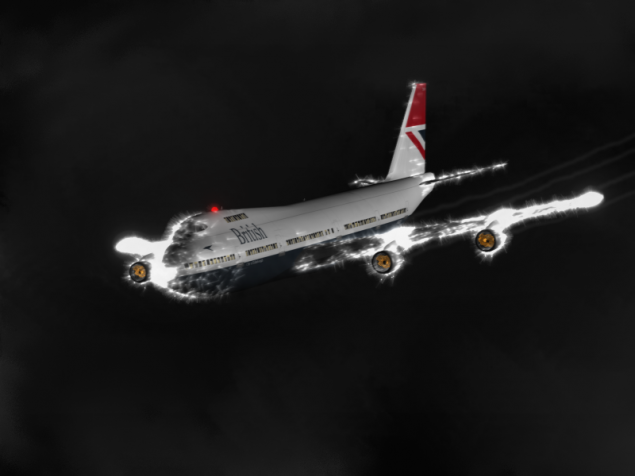
Miracle on the Hudson
New York is served by three airports, one of which - La Guardia, located in the heart of the city. Take-off, the aircraft are on the skyscrapers of Manhattan. Does not that sound like a tie for the next blockbuster in the genre of "September 11»?
At that time the situation was the same way! Day 15 January 2009 from La Guardia flew Airbus A-320 with 150 passengers on board on their way from New York - Seattle. After about 90 seconds after takeoff, the plane crashed into a flock of birds - flight data recorder recorded the shock and change in the mode of the engine. Both engines instantly "cut." At this point, the plane managed to climb 970 meters. Under the wing of the stele dense residential development 10 millionth metropolis ...
Return back to La Guardia was excluded. Stock altitude and speed was only enough for 1, 5 minutes of flight. KBC immediately decided - we go to the river! Hudson (real name - Hudson River) several times wider than the Neva River and has no significant downstream bends. The main thing was to hold on to water, carefully align the aircraft - and on business equipment. "Airbus" plopped into cold water and swam among the ice floes, like a real Titanic. The crew and all the passengers were alive (though some bad Seat 5 passengers and a flight attendant still suffered serious injuries) The main thing the hero of the story, of course, was Chesley Sullenberger - a former military pilot, once piloted "Phantom."
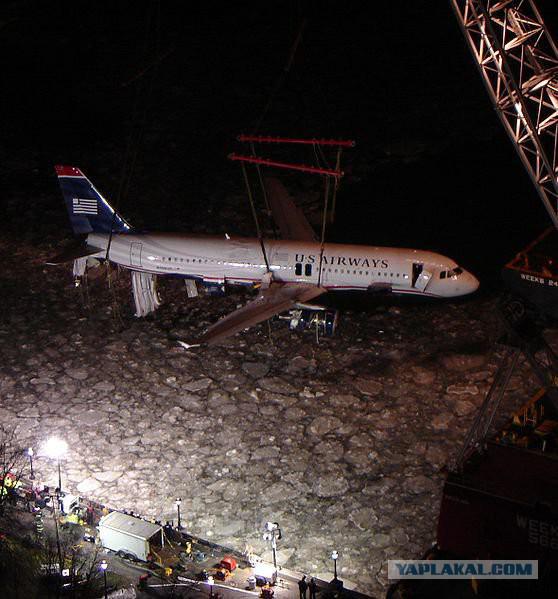
Taiga novel
September 7th, 2010 in the remote wilds of Siberia landed Airlines Tu-154 "Alrosa", coming from Yakutia - Moscow. After 3 and 5 hours after take-off on board there was a complete loss of power: turn off most devices, fuel pumps stopped, it was impossible to control the mechanization of the wing. The supply tank in the fuselage remained operational fuel load (3,300 kg), which is only enough for 30 minutes of flight. Down to a height of 3,000 meters, the pilots began a visual search for the right site for the landing of the 80-ton monster. As an artificial horizon used by ordinary glass of water.
Luck! Ahead concrete strip airport Izhma. Short - only 1350 m. At two times less than is necessary for the normal operation of the Tu-154B. In the past, there were landing aircraft grades 3-4 (Yak-42, AN-2, etc.), but in 2003 the band was finally abandoned and used only as a helipad. Here and it had to put an emergency plane. Given the impossibility of flaps and slats, landing speed "Carcasses" exceeded the estimated value of almost 100 km / h. The pilots managed to land the plane on the poorly controlled "three points", but to stay on the strip was impossible -Tu-154 rolled out in small spruce forest on 160 meters of the runway threshold. None of the 72 passengers and nine crew members was injured.
The aircraft commander EG Novoselov and copilot AA Lamanova was awarded the title Hero of the Russian Federation. The other members of the legendary crew (flight attendants, navigator and flight engineer) were awarded the Order of Courage.
The aircraft was on the ground ersatz repair on their own (!) Flew to Samara Aviation Plant "Aviacor." In the summer of 2011 to repair the machine was returned to the owner for further use in passenger avialiniyah.Avtor Oleg Kaptsov VIA
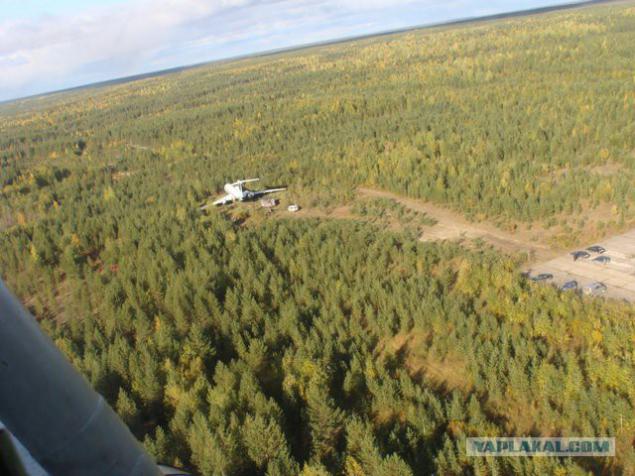
№9
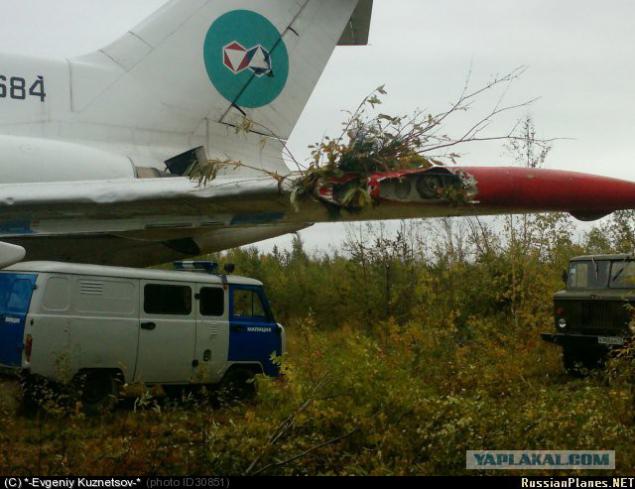
№10 ALL

Source:
In 1977, the Canary La Palma Airport rattled explosion - Bomb terrorist without harming anyone, but it was the first act in chrede horrific events of that day. All inbound planes were redirected to the small airport of Los Rodeos on the island. Tenerife, where fog, inexperienced manager and a crowded tarmac completed the begun. On the runway collision between two "747" filled with "the eyeballs" of fuel and passengers. 583 people have ascended to heaven without the help of aircraft.
Continued under the cut ...

Similarly ended landing at Irkutsk airport (2006). Already landing Airbus A-310 was deployed and cleared the runway left engine, which, as a result of erroneous actions of the crew accidentally moved during takeoff. The aircraft was destroyed and burned from aboard more than two hundred people were able to save only 78.
And yet, despite all the prejudices, aviation remains one of the safest modes of transport. Air crashes happen far less frequently than road accidents or fatal lightning strikes. Even when the engine is switched off, the failure of the control system and the landing gear stuck - on board the passengers have a good chance to return safely to the ground. Instead of hovering faulty computers and mechanization raises the human mind and inexhaustible will to win.
In the world every day is made of 50 thousand commercial flights.
1.11.2011 When approaching the Polish airport the aircraft, which fly New York - Warsaw, there were problems with the chassis. Boeing made several circles over the airport, after which the crew decided to land, according to RIA "Novosti". The aircraft made a hard landing successfully.
On board were 230 people. People brought out through the "sleeve».
On the platform they say - it is the city of Leningrad (1963)
The story of the miraculous rescue of the aircraft, which, in an attempt to prevent the fall in the middle of the northern capital, managed to splash down on the Neva.
The background is as follows: passenger airliner Tu-124 en route flight Tallinn - Moscow reported about the problems encountered on board. Immediately after takeoff, the nose landing gear jammed in poluubrannom position. The nearest airport, where it was possible to land the plane crash "in the belly" was the Leningrad airport "Pulkovo" (in those days - "highway"). There it was decided to send a "carcass».
Upon arrival, the ship began to "cut circles" over Leningrad. For the early generation of fuel he circled at an altitude of less than 500 meters, at which time the crew is actively trying to unlock the mechanism of the chassis with a metal pole. During this exciting experience and they found the news to stop the left engine due to lack of fuel. The commander and co-pilot ran to the wheel and received permission to fly over the city through urgently taken "carcass" in the direction "Pulkovo". At this time, it stops the second motor. Clearance is not enough, even on the withdrawal of the aircraft outside the Old town, this time the aircraft commander Victor Y. Mostovoy took the only right decision - to try to land the plane in the clamped in granite coast Neva. Airliner passed at a height of 90 m Foundry Bridge, ran 30 meters above Bolsheokhtinsky bridge, jumped at a height of several meters under construction bridge of Alexander Nevsky and fell into the water, almost catching wing steam tug.
Planting has turned out to be surprisingly soft: all the 45 passengers and seven crew members survived. The pilots, according to tradition, immediately took his hands KGB, however, soon had to let go of all due to the interest of the international media to this incredible landing and heroes whose actions saved five dozen people from seemingly completely hopeless situation.

The race to the death
December 31, 1988 the crew of the Tu-134 in such a hurry for the holiday table, I chose the steepest decline trajectory, ignoring the heart-rending cries of alarm too fast and rapidly approaching the earth. At speed of 460 km / h in violation of all rules and regulations were issued by the chassis. Flaps it was too late - at this speed the air flow just tore them "meat».
The speed at the moment of contact was 415 km / h (the maximum permissible value under the terms of the strength of the chassis 330 km / h). Thus, the crew of the Soviet ship found so far no one unbroken record of landing speed in civil aviation. When the 6 seconds, the speed was reduced to 380 km / h, drivers, pilots for the first time the whole flight thinking about how they would slow down. Despite all the measures taken by them (reverse engines, flaps and spoilers, deceleration) plane still skidded off the runway and stopped on the runway safety, 1, 5 meters from the descent to the ground. Fortunately, the incident affected only the head of careless drivers.

Fly gigs Aloha Airlines!
In the same 1988 there was another amazing event.
In an old "Boeing", carrying out flight from Hilo - Honolulu (Hawaiian Islands) due to explosive decompression blew off 35 square meters. meter fuselage skin. The incident occurred at an altitude of 7300 meters at a flight speed of 500 km / h. 90 passengers in an instant turned into a roaring stream of air, the speed of which is 3 times the speed of the hurricane; when the air temperature behind -45 ° S.Piloty urgently declined and dropped the speed to 380 km / h, however, 65 people had to pour injuries and frostbite of varying severity. After 12 minutes the plane with a minute deviation from landing at the airport of Honolulu.
The only victim of the accident was unusual stewardess - unhappy thrown overboard at the time of the destruction of the fuselage.

"Gimli Glider" (1983) and "The pilots of the Century" (2001)
"Gimli Glider" - a name wore Boeing 767-233 (w / C-GAUN 22520/47) airlines Air Canada, has made an amazing feat. 132-ton airplane to stop the engine carefully planned with a height of 12 000 meters and landed safely at an abandoned airbase Gimli (where at the moment carried out racing). The situation is complicated power shortages, resulting in disconnected many flight instruments. A hydraulic pressure was so low that the pilots could barely move with the ailerons and rulyami.Prichina incident - error airport ground services in Ottawa, muddle kilograms and pounds. As a result, the tanks of the aircraft instead of the required 20 tonnes received less than 5 tons of kerosene. The situation was saved only presence in the cockpit of an experienced CF Robert Pearson (at leisure - glider amateur) and co-pilot, a former military pilot M.Kvintala who knew of the existence of an abandoned runway Gimli.
Interestingly, a similar incident occurred in 2001 when the Atlantic Ocean stalled engines of the French "Airbus" flying from Toronto Lisbon. KBC Robert Piché
and co-pilot Dirk de Jager able to fly on the "glider" and another 120 km to make a soft landing at Lajes Air Base in the Azores.

Flying over the crater of the volcano (1982)
... The flight attendant handed a cup of coffee and, as if by chance, looked out the window. Seen behind left no doubt: fear of the pilots were not in vain. From both engines came strange glow, like a flash strobes. Soon, the cabin appeared suffocating smell of sulfur and smoke. Commander Eric Moody was forced to make one of the most naive statements in the history of civil aviation:
"Ladies and gentlemen, said the commander of the aircraft. We have a small problem, all four engines stopped. We do our best to start them. I hope this does not cause you too much trouble »
No one at that time was on board 248 passengers and 15 crew members had no idea that "747" flew through the cloud of volcanic ash ejected suddenly awakened volcano galunggung (Indonesia). The smallest abrasive particles scored engines and fuselage skin damaged by putting flight №9 (London-Oakland) to the brink of disaster.
The huge ship was planning a night on the ocean. Straight ahead I grew ridge on the south coast of. Java. The crew had to decide - whether they have enough height to fly over the barrier and make an emergency at the airport in Jakarta, and is immediately put into the water jet. While KBC together with the Indonesian controller calculated the remaining distance and aerodynamic quality of the aircraft, the co-pilot and flight engineer did not stop efforts to restart the engines. And, lo and behold! Fourth motor sneezing, spitting out volcanic pumice ourselves, and rhythmically jerk whistle. Gradually I managed to put into operation two of the engine - thrust was enough to make it to the airport, but on the landing glidepath another problem: the windshield was excised abrasive particles and totally lost transparency. The situation complicated the lack of an automatic actuator for a landing at the airport in Jakarta. As a result, the British still managed to safely land the plane, looking through two tiny preserve transparency area on the windshield. None of the people on board was injured.

Miracle on the Hudson
New York is served by three airports, one of which - La Guardia, located in the heart of the city. Take-off, the aircraft are on the skyscrapers of Manhattan. Does not that sound like a tie for the next blockbuster in the genre of "September 11»?
At that time the situation was the same way! Day 15 January 2009 from La Guardia flew Airbus A-320 with 150 passengers on board on their way from New York - Seattle. After about 90 seconds after takeoff, the plane crashed into a flock of birds - flight data recorder recorded the shock and change in the mode of the engine. Both engines instantly "cut." At this point, the plane managed to climb 970 meters. Under the wing of the stele dense residential development 10 millionth metropolis ...
Return back to La Guardia was excluded. Stock altitude and speed was only enough for 1, 5 minutes of flight. KBC immediately decided - we go to the river! Hudson (real name - Hudson River) several times wider than the Neva River and has no significant downstream bends. The main thing was to hold on to water, carefully align the aircraft - and on business equipment. "Airbus" plopped into cold water and swam among the ice floes, like a real Titanic. The crew and all the passengers were alive (though some bad Seat 5 passengers and a flight attendant still suffered serious injuries) The main thing the hero of the story, of course, was Chesley Sullenberger - a former military pilot, once piloted "Phantom."

Taiga novel
September 7th, 2010 in the remote wilds of Siberia landed Airlines Tu-154 "Alrosa", coming from Yakutia - Moscow. After 3 and 5 hours after take-off on board there was a complete loss of power: turn off most devices, fuel pumps stopped, it was impossible to control the mechanization of the wing. The supply tank in the fuselage remained operational fuel load (3,300 kg), which is only enough for 30 minutes of flight. Down to a height of 3,000 meters, the pilots began a visual search for the right site for the landing of the 80-ton monster. As an artificial horizon used by ordinary glass of water.
Luck! Ahead concrete strip airport Izhma. Short - only 1350 m. At two times less than is necessary for the normal operation of the Tu-154B. In the past, there were landing aircraft grades 3-4 (Yak-42, AN-2, etc.), but in 2003 the band was finally abandoned and used only as a helipad. Here and it had to put an emergency plane. Given the impossibility of flaps and slats, landing speed "Carcasses" exceeded the estimated value of almost 100 km / h. The pilots managed to land the plane on the poorly controlled "three points", but to stay on the strip was impossible -Tu-154 rolled out in small spruce forest on 160 meters of the runway threshold. None of the 72 passengers and nine crew members was injured.
The aircraft commander EG Novoselov and copilot AA Lamanova was awarded the title Hero of the Russian Federation. The other members of the legendary crew (flight attendants, navigator and flight engineer) were awarded the Order of Courage.
The aircraft was on the ground ersatz repair on their own (!) Flew to Samara Aviation Plant "Aviacor." In the summer of 2011 to repair the machine was returned to the owner for further use in passenger avialiniyah.Avtor Oleg Kaptsov VIA

№9

№10 ALL

Source:
Tags
See also
10 of the most famous in the history of betting (9 photos)
10 photos of the most significant in the history of
The royal path for the most desperate tourists
The strange weapon in the history of mankind
Drawings of the most brutal killers in history
The most expensive mistakes in history
50 most undervalued films in the history of cinema
15+ baby pictures the most terrible in human history
The strangest match in the history of football
The most deadly plane crash in US history

















